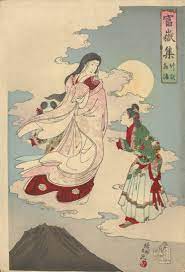By: AJ Witte
This reading which was the telling of the Japanese folk story “The Tale of the Bamboo Cutter,” focused on the idea on the Japanese idea of mono no aware, or the idea that we should find beauty in the passing of things. Or rather the fact that there is beauty in the impermanence of things. The bamboo cutter himself I feel embodies this idea far better than any other character, as he becomes inseparable from his newfound daughter, whom we eventually find out is the daughter of the moon kingdom whom must eventually make her return as she is serving out a sentence amongst the lower humans. We see his gradual shift from loving father figure whom he wants to see move on to quasi obsessed man who is ready to die for his daughter, “What’s that you say? I found in a stick of bamboo when you were no bigger than a poppy seed, and I have brought you up until now you stand as tall as I. Who is going to take my child away? Do you think I’ll let them?’ He added, ‘If they do, I will kill me.’” (Haruo Shirane 180). While it is completely understandable that a father may be distraught to find his daughter leaving his nest so to speak, but The Tale of the Bamboo Cutter at least to me is a cautionary tale as to not hold too tightly for fear of loss, but rather to find beauty in that loss. I think that this ties all the way back to one of our original conversations about Japanese fatalism where in there is a certain type of determinism found in much of the culture in Japan. To me mono no aware and by extension The Tale of the Bamboo Cutter is a natural progression of such an idea. In the story we see that it is fated that the bamboo cutters daughter must return back, there is no escaping that. And rather than be sad, to rather find beauty in the passing. It is not terrible to lose, but rather it is a time of transition and beauty in transition. I would also be remised if I were not to mention just how important a story such as this can be, as in the hit series Avatar: The Last Airbender, one of the main characters Sokka falls in love with a woman who turns out to be the daughter of the moon, and as such must eventually return to her rightful place as the moon in order to protect her people. Sokka while heartbroken finds beauty in her sacrifice and in the fact that she must leave, a far more apt usage of mono no aware, as compared to the more cautionary tale of The Tale of the Bamboo Cutter.
Sources:
“The Tale of the Bamboo Cutter” (Taketori monogatari).In Traditional Japanese Literature : An Anthology, Beginnings to 1600. Abridged ed., edited by Haruo Shirane. Translations from the Asian Classics. New York: Columbia University Press, 2012.

